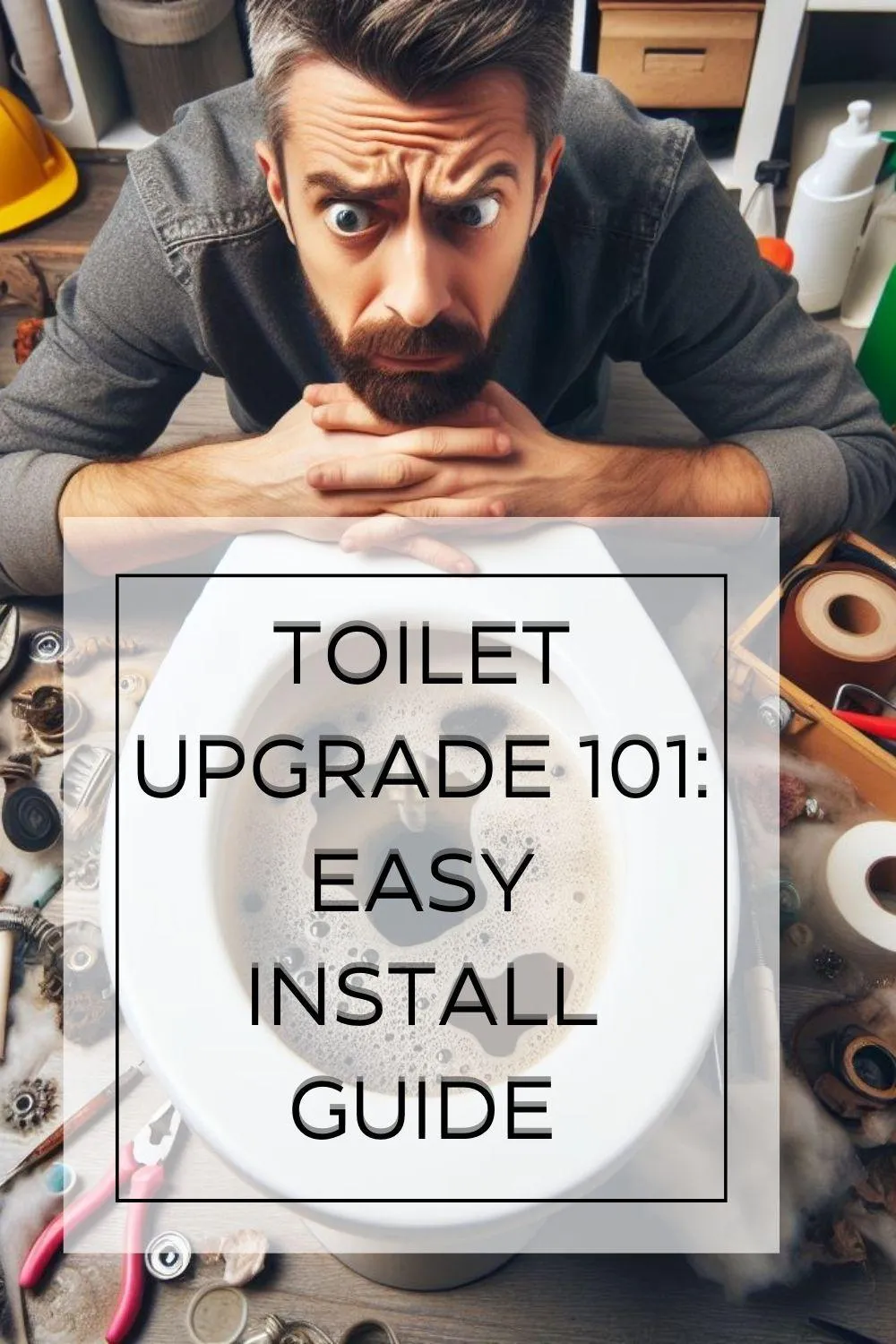
Toilet Upgrade 101: Easy Install Guide
Toilet Upgrade 101: Easy Install Guide
Introduction:
Welcome to Your Ultimate Toilet Upgrade Journey!
Embarking on the journey of upgrading your toilet is not just about enhancing the aesthetics of your bathroom; it's about improving functionality and comfort in your daily life. Get ready to dive into the world of toilet upgrades, where we'll explore everything from the initial assessment to the final touches and maintenance tips.
Why Upgrade Your Toilet? The Benefits You Didn't Know
While it may seem like a mundane task, upgrading your toilet can bring about a plethora of benefits that you may not have considered before. From water efficiency to improved hygiene and even increased property value, there's more to toilet upgrades than meets the eye.

Assessing Your Current Toilet: Is It Time for an Upgrade?
Before diving into the upgrade process, it's essential to assess the condition of your current toilet. Look out for signs of wear and tear, such as cracks, leaks, or inefficient flushing. These indicators will help you determine whether it's time for an upgrade.
Signs Your Toilet Needs an Upgrade
Persistent leaks or water stains around the base of the toilet
Difficulty flushing or frequent clogs
Cracks or damage to the porcelain
Outdated design or lack of water-saving features
Choosing the Right Replacement: Types of Toilets Explained
With a myriad of toilet options available on the market, choosing the right replacement can be overwhelming. From traditional gravity-fed toilets to modern dual-flush and wall-mounted options, each type has its unique features and benefits.
Gathering Your Tools and Materials: What You'll Need for the Job
Before diving into the installation process, gather all the necessary tools and materials to ensure a smooth upgrade experience. From wrenches and screwdrivers to wax rings and caulking, having everything on hand will save you time and frustration.
Essential Tools for Toilet Installation
Adjustable wrench
Screwdriver set
Hacksaw (if cutting pipes)
Plumber's putty or silicone sealant
Level
Teflon tape
Materials Checklist: Don't Forget Anything!
New toilet
Wax ring
Toilet bolts and caps
Water supply line
Caulk or sealant
Disposable gloves
Bucket (for draining water)
Pre-Installation Prep
Clearing the Space: Preparing Your Bathroom for the Upgrade
Before beginning the installation process, clear the surrounding area to provide ample space to work. Remove any rugs, mats, or bathroom accessories that may obstruct the installation process.
Decluttering and Cleaning Tips
Take this opportunity to declutter and clean your bathroom thoroughly. Remove any items from the area around the toilet to prevent them from getting in the way during installation.
Safety First: Precautions to Take
When working with plumbing fixtures, it's essential to prioritize safety. Before starting the upgrade process, ensure that the electricity and water supply to the bathroom are turned off to prevent accidents.
Shutting Off the Water Supply: How to Safely Disconnect Your Toilet
Before removing the old toilet, it's crucial to shut off the water supply to prevent leaks or flooding. Locate the water shut-off valve near the base of the toilet and turn it clockwise to shut off the water flow.
Finding Your Water Shut-Off Valve
The water shut-off valve is typically located on the wall behind or beside the toilet. It may be a knob or lever that you can turn to shut off the water supply.
Draining the Toilet: Step-by-Step Instructions
Once the water supply is turned off, flush the toilet to drain the remaining water from the tank and bowl. Use a plunger or sponge to remove any excess water from the bowl and tank.
Removing the Old Toilet
Saying Goodbye to the Old Throne: Step-by-Step Removal Process
With the water supply turned off and the toilet drained, it's time to bid farewell to the old toilet. Follow these step-by-step instructions to remove the old fixture safely.
How to Disconnect the Water Supply Line
Using an adjustable wrench, loosen the nuts connecting the water supply line to the toilet tank. Once loosened, carefully remove the water supply line and set it aside.
Removing the Toilet Bowl and Tank
To remove the toilet bowl and tank, start by disconnecting the tank from the bowl. Loosen the bolts securing the tank to the bowl and carefully lift the tank off the bowl. Next, remove the bolts securing the bowl to the floor and lift the bowl off the flange.
Dealing with Old Sealants and Caulk: Cleaning Up the Mess
After removing the old toilet, you may encounter remnants of old sealants and caulk around the flange. Use a scraper or putty knife to remove any residue, ensuring a smooth surface for the installation of the new toilet.
Scraping Away Residue: Tips for a Smooth Surface
Take your time to scrape away any stubborn residue, being careful not to damage the flooring or flange. A clean and smooth surface is essential for a proper seal with the new toilet.
Proper Disposal: Eco-Friendly Options
Dispose of the old toilet responsibly by taking it to a local recycling center or waste disposal facility. Many municipalities offer special programs for the recycling of porcelain fixtures, helping to reduce landfill waste.
Installing the New Toilet
Unboxing Your New Toilet: What to Look for Before Installation
Before installing the new toilet, carefully inspect the packaging for any signs of damage or defects. Check that all components, including the bowl, tank, and seat, are present and in good condition.
Checking for Damages or Defects
Inspect the porcelain surfaces for cracks, chips, or imperfections that may affect the performance or aesthetics of the toilet. Check all fittings and components to ensure they are intact and undamaged.
Familiarizing Yourself with the Components
Take a moment to familiarize yourself with the components of the new toilet, including the bowl, tank, wax ring, bolts, and caps. Understanding how each part fits together will make the installation process smoother.
Placing the Wax Ring: Ensuring a Secure Seal
The wax ring creates a watertight seal between the toilet and the flange, preventing leaks and odors. Properly positioning the wax ring is essential for a secure and effective seal.
Proper Positioning: Tips for Success
Carefully place the wax ring on the flange, ensuring that it is centered and evenly compressed. Gently press down on the toilet bowl to secure the wax ring in place, taking care not to shift its position.
Avoiding Common Mistakes
Avoid common mistakes, such as using too much or too little wax, which can result in leaks or an unstable toilet. Follow the manufacturer's instructions and guidelines for proper wax ring installation.
Setting the New Toilet in Place: A Step-by-Step Guide
With the wax ring in place, it's time to set the new toilet in position. Follow these step-by-step instructions for a successful installation.
Lifting and Aligning the Toilet Bowl
Carefully lift the toilet bowl and lower it onto the flange, ensuring that it is aligned with the bolts protruding from the flange. Gently press down on the bowl to compress the wax ring and create a secure seal.
Attaching the Tank: Securing Properly
Once the bowl is in place, attach the tank by aligning it with the bowl and securing it with the bolts provided. Tighten the bolts evenly to ensure a snug fit, taking care not to over-tighten and risk damaging the porcelain.
Final Touches and Testing
Connecting the Water Supply: Reattaching the Lines
With the toilet securely in place, it's time to reconnect the water supply line. Use an adjustable wrench to tighten the nuts, ensuring a secure connection that prevents leaks.
How to Properly Reconnect the Water Supply Line
Slide the water supply line onto the threaded valve on the bottom of the toilet tank and tighten the nut securely. Turn on the water supply and check for any leaks around the connections.
Turning On the Water: Checking for Leaks
Slowly turn on the water supply and allow the tank to fill. Check for any leaks around the base of the toilet, as well as the connections between the tank and bowl.
Securing the Toilet in Place: Bolting It Down
Once you've confirmed that there are no leaks, secure the toilet in place by tightening the bolts at the base. Use a wrench to tighten the bolts evenly, taking care not to over-tighten and crack the porcelain.
Tightening the Bolts: Ensuring Stability
Properly tightened bolts are essential for ensuring the stability and longevity of your new toilet. Check the bolts periodically and tighten them as needed to prevent wobbling or instability.
Testing Stability: Safeguarding Against Wobbles
Gently rock the toilet from side to side to test its stability. If the toilet wobbles or shifts, tighten the bolts further until it feels secure and stationary.
Cleanup and Maintenance Tips
Cleaning Up After Installation: Making Your Bathroom Shine
With the installation complete, take some time to clean up any debris or mess left behind. Wipe down the toilet and surrounding area with a mild cleaner to remove any dirt or dust.
Removing Excess Caulk and Sealants
If you used caulk or sealant during the installation process, use a damp cloth or sponge to remove any excess residue. Ensure that the area around the toilet is clean and dry before using the bathroom.
Disposing of Old Fixtures Responsibly
Dispose of any old fixtures or materials in accordance with local regulations. Consider recycling or repurposing old parts to minimize waste and reduce your environmental impact.
Maintaining Your New Toilet: Tips for Longevity and Performance
To keep your new toilet in top condition, follow these maintenance tips to ensure longevity and optimal performance.
Regular Cleaning Schedule
Develop a regular cleaning schedule to keep your toilet clean and hygienic. Use a mild cleaner and a soft brush or sponge to remove stains and buildup from the bowl and tank.
Troubleshooting Common Issues
Be proactive in addressing any issues that may arise with your new toilet. From leaks and clogs to running toilets and weak flushes, knowing how to troubleshoot common problems will help keep your toilet functioning smoothly.
Conclusion
Congratulations on Your Successful Toilet Upgrade!
You've successfully completed your toilet upgrade journey, transforming your bathroom into a functional and stylish space with the help of Zip Appliance Repair and Service. Enjoy the benefits of your new toilet and revel in the satisfaction of a job well done.
Final Thoughts and Happy Flushing!
We hope this comprehensive guide, brought to you by Zip Appliance Repair and Service, has equipped you with the knowledge and confidence to tackle your toilet upgrade with ease. Remember to follow proper installation techniques and maintenance practices to keep your toilet in tip-top shape for years to come. For any further assistance or questions, contact us directly at (661) 387-2282 or schedule a service online. Happy flushing!
